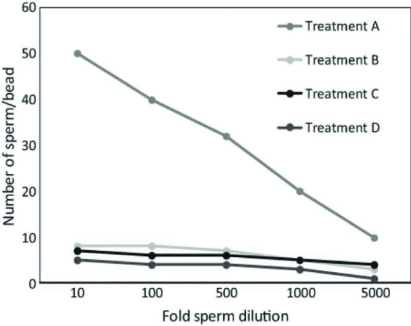Use the following information to answer the question.
In an investigation into sperm-oocyte binding, researchers isolated the egg receptor protein, ERB1, from the sea urchin Strongylocentrotus purpuratus. ERB1 binds to the sperm acrosomal protein, bindin, during fertilization. The researchers coupled the ERB1 receptor from S. purpuratus to plastic microbeads and then mixed the ERB1-coupled beads with sperm from S. purpuratus or from the related species, S. franciscanus. A summary of the treatment mixtures and a graph of the results are shown.
Treatments:
A: S. purpuratus sperm mixed with S. purpuratus ERB1-coupled beads
B: S. purpuratus sperm mixed with beads with no coupled ERB1 protein
C: S. franciscanus sperm mixed with S. purpuratus ERB1 beads
D: S. franciscanus sperm mixed with beads with no coupled ERB1 protein 
Which of the following is a broader implication from the observations of the experiment?
A) In sea urchins, fertilization of eggs by sperm is dependent upon species-specific protein interactions.
B) Only some species of sea urchins use receptor proteins on their eggs to bind sperm.
C) Protein-coated plastic beads should not be used to test sperm binding to eggs.
D) S. franciscanus is probably not a sea urchin, but must be some other type of organism.
Correct Answer:
Verified
Q15: Which of the following structures is formed
Q16: Which of the following correctly describes a
Q17: Under which condition will the metabolic activity
Q18: Release of the acrosomal contents during fertilization
Q19: Which of the following answers best describes
Q21: Which of the following correctly describes the
Q22: Thalidomide, now banned for use as a
Q23: Which correctly matches the organ with its
Q24: During which stage of development do cells
Q25: The migratory neural crest cells give rise
Unlock this Answer For Free Now!
View this answer and more for free by performing one of the following actions

Scan the QR code to install the App and get 2 free unlocks

Unlock quizzes for free by uploading documents